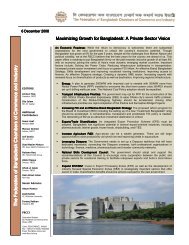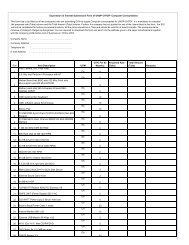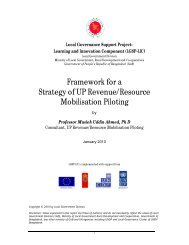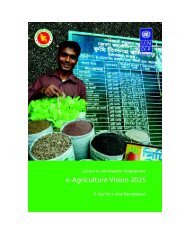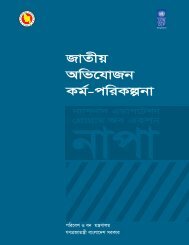The probable impacts of climate change on poverty - UNDP
The probable impacts of climate change on poverty - UNDP
The probable impacts of climate change on poverty - UNDP
You also want an ePaper? Increase the reach of your titles
YUMPU automatically turns print PDFs into web optimized ePapers that Google loves.
6.2.2 Future Impacts – Percepti<strong>on</strong><br />
<str<strong>on</strong>g>The</str<strong>on</strong>g> <str<strong>on</strong>g>probable</str<strong>on</strong>g> <str<strong>on</strong>g>impacts</str<strong>on</strong>g> <str<strong>on</strong>g>of</str<strong>on</strong>g> <str<strong>on</strong>g>climate</str<strong>on</strong>g> <str<strong>on</strong>g>change</str<strong>on</strong>g> <strong>on</strong> crop agriculture will be aggravated in future since the frequency and<br />
intensity <str<strong>on</strong>g>of</str<strong>on</strong>g> shocks and erratic behaviour <str<strong>on</strong>g>of</str<strong>on</strong>g> rainfall and temperature will increase, stated by the key experts <str<strong>on</strong>g>of</str<strong>on</strong>g><br />
agriculture sector. Historical data also states that frequency and intensity <str<strong>on</strong>g>of</str<strong>on</strong>g> flood and cycl<strong>on</strong>e will increase which<br />
will affect crop agriculture at a greater scale. <str<strong>on</strong>g>The</str<strong>on</strong>g> major effects <str<strong>on</strong>g>of</str<strong>on</strong>g> <str<strong>on</strong>g>climate</str<strong>on</strong>g> <str<strong>on</strong>g>change</str<strong>on</strong>g> will include <str<strong>on</strong>g>change</str<strong>on</strong>g>s in<br />
cropping pattern and crop variety, reducti<strong>on</strong> <str<strong>on</strong>g>of</str<strong>on</strong>g> coverage <str<strong>on</strong>g>of</str<strong>on</strong>g> Rabi crops, <str<strong>on</strong>g>change</str<strong>on</strong>g>s <str<strong>on</strong>g>of</str<strong>on</strong>g> Boro seas<strong>on</strong>, extent <str<strong>on</strong>g>of</str<strong>on</strong>g><br />
damage <str<strong>on</strong>g>of</str<strong>on</strong>g> standing crops. T. Aman, wheat and pulses will suffer more due to increase severity and area <str<strong>on</strong>g>of</str<strong>on</strong>g><br />
drought. <str<strong>on</strong>g>The</str<strong>on</strong>g> experts from SRDI informed that the high land crop will be affected by <str<strong>on</strong>g>climate</str<strong>on</strong>g> <str<strong>on</strong>g>change</str<strong>on</strong>g> very<br />
severely, medium high land severely and medium lowland & low land will be un<str<strong>on</strong>g>change</str<strong>on</strong>g>d. It is also informed that<br />
most <str<strong>on</strong>g>of</str<strong>on</strong>g> the climatic events will degrade the quality <str<strong>on</strong>g>of</str<strong>on</strong>g> soil. <str<strong>on</strong>g>The</str<strong>on</strong>g> resp<strong>on</strong>dent said that the more developed soil, the<br />
poorer quality <str<strong>on</strong>g>of</str<strong>on</strong>g> soil. Frequent flood, erratic rainfall and temperature variati<strong>on</strong> will increase biotic activity,<br />
decompositi<strong>on</strong>, porosity and permeability <str<strong>on</strong>g>of</str<strong>on</strong>g> soil which will affect crop agriculture. <str<strong>on</strong>g>The</str<strong>on</strong>g>se <str<strong>on</strong>g>impacts</str<strong>on</strong>g> will vary in<br />
different ecological z<strong>on</strong>es. <str<strong>on</strong>g>The</str<strong>on</strong>g> following tables show the percepti<strong>on</strong>s <str<strong>on</strong>g>of</str<strong>on</strong>g> future <str<strong>on</strong>g>impacts</str<strong>on</strong>g> <str<strong>on</strong>g>of</str<strong>on</strong>g> <str<strong>on</strong>g>climate</str<strong>on</strong>g> <str<strong>on</strong>g>change</str<strong>on</strong>g>,<br />
variability and extremes in different ecological z<strong>on</strong>es <strong>on</strong> crop agriculture:<br />
Table 6.7 Percepti<strong>on</strong> <str<strong>on</strong>g>of</str<strong>on</strong>g> Future Level <str<strong>on</strong>g>of</str<strong>on</strong>g> Impacts related to Climate Change in the Flood pr<strong>on</strong>e areas<br />
Major <str<strong>on</strong>g>change</str<strong>on</strong>g>s and <str<strong>on</strong>g>impacts</str<strong>on</strong>g><br />
Crop loss/yield<br />
reducti<strong>on</strong> (%)<br />
Depositi<strong>on</strong> <str<strong>on</strong>g>of</str<strong>on</strong>g> SOM will be increased in low-lying areas 10<br />
Minerals and coarse materials will be increased in char lands with areas and<br />
10<br />
extent<br />
Cropping pattern, cropping seas<strong>on</strong> and variety <str<strong>on</strong>g>of</str<strong>on</strong>g> crops will be <str<strong>on</strong>g>change</str<strong>on</strong>g>d 10<br />
Coverage <str<strong>on</strong>g>of</str<strong>on</strong>g> rabi crops will be decreased 15<br />
Prol<strong>on</strong>ged flood/Late flood will delay rabi crops 10<br />
Increase intensity/severity <str<strong>on</strong>g>of</str<strong>on</strong>g> flash floods will hamper Boro cultivati<strong>on</strong> in Haor<br />
50<br />
basins<br />
Overall cropyield will be decreased due to degradati<strong>on</strong> <str<strong>on</strong>g>of</str<strong>on</strong>g> soil quality and<br />
15<br />
climatic hazards<br />
Table 6.8 Percepti<strong>on</strong> <str<strong>on</strong>g>of</str<strong>on</strong>g> Present Level <str<strong>on</strong>g>of</str<strong>on</strong>g> Impacts related to Climate Change in the Drought Pr<strong>on</strong>e Areas<br />
46<br />
Major <str<strong>on</strong>g>change</str<strong>on</strong>g>s and <str<strong>on</strong>g>impacts</str<strong>on</strong>g><br />
Soil reserve nutrients will be decreased due to increased mineralizati<strong>on</strong>,<br />
depleti<strong>on</strong> <str<strong>on</strong>g>of</str<strong>on</strong>g> SOM and intensive cultivati<strong>on</strong><br />
Dry-land crop varieties will be <str<strong>on</strong>g>change</str<strong>on</strong>g>d<br />
T. Aman will highly be affected by drought and moisture stress<br />
Chickpea, tomato will be affected at higher temperature<br />
Flowering and grain-filling stage <str<strong>on</strong>g>of</str<strong>on</strong>g> wheat and T. Aman will be affected seriously by<br />
temperature variati<strong>on</strong> and decreased winter period and moisture stress<br />
Sterility <str<strong>on</strong>g>of</str<strong>on</strong>g> wheat, pulses and oilseeds will be increased due to increased fogginess<br />
Seedlings <str<strong>on</strong>g>of</str<strong>on</strong>g> Boro will be hampered due to cold wave<br />
Cold wave will affect mustard, chickpea, lentil, and other rabi crops at the stage <str<strong>on</strong>g>of</str<strong>on</strong>g><br />
flowering and grain filling and cause yield reducti<strong>on</strong><br />
Disease <str<strong>on</strong>g>of</str<strong>on</strong>g> potato will be increased due to cold wave and fogginess<br />
Crop loss/Yield<br />
reducti<strong>on</strong><br />
<str<strong>on</strong>g>The</str<strong>on</strong>g> Probable Impacts <str<strong>on</strong>g>of</str<strong>on</strong>g> Climate Change <strong>on</strong> Poverty and Ec<strong>on</strong>omic Growth and<br />
the Opti<strong>on</strong>s <str<strong>on</strong>g>of</str<strong>on</strong>g> Coping with adverse Effect <str<strong>on</strong>g>of</str<strong>on</strong>g> Climate Change in Bangladesh<br />
20<br />
30<br />
TA-30, wheat 20<br />
and mustard 10<br />
30<br />
30<br />
10<br />
20<br />
20




